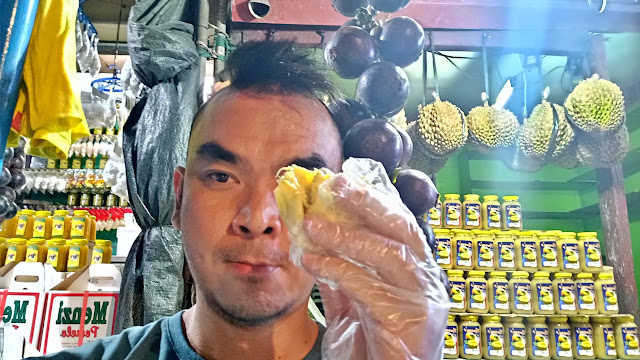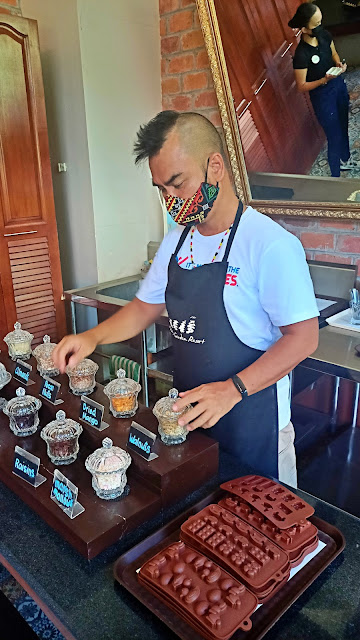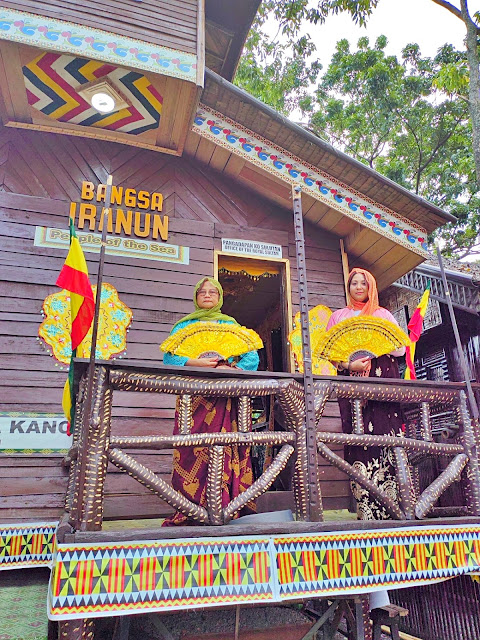The last leg of our post-PHITEX’s Nature and Adventure familiarization trip took us to Davao City and the Island Garden City of Samal, where we soaked ourselves in local culture and gastronomic fare and had some much-needed R&R in the great outdoors.
 |
| Getting ready to spot some giant clams |
After four days of exploring Cagayan de Oro and parts of Bukidnon, the group is looking forward to some downtime sinking our bodies into the salty waters of Davao Gulf, the same body of water frequented by an array of species of toothed whales and dolphins.
But first, we need to pass first the largest city in the country in terms of land area, Davao City.
Take a Bow, Davao
Just when the bustling activities in Davao mirrors other big cities in the Philippines, the towering presence of Mt. Apo instantly looms and reminds visitors of the duality of Davao as an urban and countryside setting.
 |
| But first, have a mouthful of Durian fruit when in Davao |
With only a full day to spare before we head off to Samal Island, our group made the most by making a series of stops at a few of the landmark places in the city that best typify its character, which is rich in tradition, history, heritage, flora and fauna, and arts.
 |
| Trying my hands at the basic of chocolate making |
We tried our hands at chocolate making at the Malagos Chocolate Museum, which is located within the Malagos Garden Resort. While we didn't get to see the entire process because the first seven processes of chocolate creation can take from a few days to a few weeks, we did get to experience first-hand the molding part, which is the eighth of a nine-step process followed by Malagos.
.jpg) |
| A cultural dance performance happens as part of the lunch experience in Malagos |
This is the part where you just need to pour the tempered chocolate into a molding tray with various shapes together with small amount of fillings such as walnuts, almonds, dried mango, raisins and more. Afterward for the final phase, our creations were cooled for half an hour to achieve the finished form that one can quickly bite and melt in their mouth.
.jpg) |
| Malagos Chocolate Museum |
We also learned that Malagos produces chocolates from single-origin cacao beans grown and harvested on their farm located on the foothills of Mt. Talomo — a dormant volcano beside Mt. Apo.
.jpg) |
| Aside from the sumptuous buffet dishes, platters of appetizers were also served |
Before our visit to Malagos Museum, we had our Davao-themed buffet lunch inside the resort where we were treated to cultural show featuring young performers from the Malagos community. The show, which combines Bagobo dance with folk dances to portray the stories of several communities and their own festivities, is a representation of the region's rich and varied cultural heritage.
.jpg) |
| Rescued and rehabilitated Eagles are taken care off at the Philippine Eagle Center |
After a short 10 minute drive from Malagos, we arrive at the Philippine Eagle Center. At first glance, one would wonder why such mesmerizing, winged monarchs of the sky are kept here and caged. However, after hearing from the tour guides, visitors will realize that the center's primary mission is to rehabilitate eagles of diverse types — especially survivors of poaching — before setting them back free in the wild and operate as a breeding facility to protect the critically endangered National Bird of the Philippines.
.jpg) |
| Some like "Pagbabago" are hatched in the center and are being trained to be set into the wild |
The 8.4 hectare facility located on the foothills of Mount Apo houses more than 30 Philippine Eagles, with half of them being captive bred. Seeing what famed aviator Charles Lindbergh described as "the air's noblest flier" up close, was an awesome experience.
.jpg) |
| "Magiting" is up there somewhere |
Capping off our Davao trip is a stop at Magsaysay Park for some Durian fruit tasting and an educational lecture from our guide about the region's diverse ethnolinguistic communities.
.jpg) |
| One of the traditional Mindanaoan house replicas in Magsaysay Park |
Named in honor of former Philippine President Ramon Magsaysay, the park sits on a sprawling space facing the waters of Davao Gulf. Aside from the 25 meter tri-pillar obelisk tower with the statue of President Magsaysay, the park is noted for its exquisite replicas of the dwellings of Mindanao's 11 tribes, as well as various art installations done by local artists.
 |
| Visitors can even try donning traditional clothing |
Snippets of arts and other crafts are displayed on each house models symbolizing the diverse culture of the 11 ethnolinguistic communities in Mindanao namely the Sama, Tausug, Maranao, Ata, Matigsalug, Bagobo-K'lata, Bagobo-Tagabawa, Obu-Manuvu, Iranun, Kagan and Maguindanaon.
To the Bat Cave and Beaches of Samal Island
We completed our fantastic journey with a two-night stay on Samal Island, namely at the Discovery Samal Resort, which began operation just this June 2023.
.JPG) |
| Discovery Samal — our home on the island |
This property boasts more than 150 huge rooms and suites along with three large pools running parallel in different elevations along the beach and encircled by a tangle of canopy trees, gardens, and trails leading to the property's many amenities.
.jpg) |
| The inviting beach of Discovery Samal |
While the preceding four days have been filled with stimulating activities at every turn, our party relished the opportunity to simply relax by the pool or on the beachfront of this spectacular resort, and we did exactly that upon arrival.
Since rest is for the weak and exploring is for the wanderers in our group, our Nature and Adventure activities continued the next day with a snorkeling trip to the Giant Clam Sanctuary or otherwise known as Taklobo (local word for “giant clams”) Sanctuary.
%20Sanctuary%20(19).JPG) |
| Our German companion hurriedly went into the water |
More than 3,700 giant clams, including more than 3,000 considered adult, call this 14-hectare marine protected area home. These huge clams are being kept for study and conservation efforts thanks to a partnership between Davao del Norte State College (DNSC), AdeCor United Fisherfolks Organization (ACUFOR), and the Local Government Unit (LGU) of Samal.
%20Sanctuary%20(11).JPG) |
| Clear waters as far as the eyes can see |
The Sanctuary's resident tour guide gave us a fascinating briefing before we dove into the water, enlightening us about the clams and other marine species thriving in the vicinity. Our guide also stressed that individuals should refrain from touching the aquatic organisms, since they are extremely fragile and can be killed by even the slightest action of unguided curiosity.
.jpg) |
| Guests are briefed first before entering the bat caves |
The gigantic clams in the shallow sea shone like flowers in bloom as our group approached, with their brilliant colours shimmering from hues of blue to violet and other rainbow colors.
.jpg) |
| Home to millions of Rousette fruit bats |
If giant clams hold court on the waters of Samal, inland, the bats lord over inland in large numbers at the Monfort Bat Sanctuary. This 57-acre site is home to the largest single bat colony in the world, consisting of almost 3 million Rousette fruit bats.
.jpg) |
| the bat covered mouth of the cave |
The Iñigo-Monfort initially bought this piece of land in the early 1900s only to discover a network of caves that were home to thousands of bats and would grow to house millions over the course of several decades. In spite of the unpleasant smell of bat drippings and the initial shock of seeing so many of them up close, the sight of them hanging upside down practically covering every inch of the cave is a surreal image that further reminds you of the strangeness and wonders of nature.
.jpg) |
| Fire dancers performing on the beach of Discovery Samal |
It was apparent how Mindanao’s rich culture and the nature wonders of Samal Island left a lasting impression on our foreign participants. I could sense their astonishment as they absorbed all the incredible experiences we had, from exploring Cagayan de Oro to venturing into Bukidnon. Finally, on our last night, we gathered once more on the pristine white sands of Discovery Samal, indulging in a delightful buffet dinner while being entertained by mesmerizing fire dance performers. The breathtaking starry skies that added to the enchanting ambiance of the night aptly ended our Nature and Adventure trip on a high note.
As we said our farewells the following morning, all eight foreign sellers in our group made a pledge to not only promote the places we visited, but also the entire Philippines to their clients in their respective countries.
And with that, this year’s Philippine Travel Exchange (PHITEX) comes to a close. See you all next year.
This article first appeared on the 2023 3rd quarter issue of asianTraveler Magazine.






















